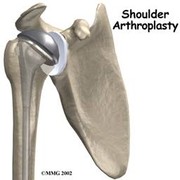Monthly Archives: July 2012
Things to be Aware of with Shoulder Replacement Surgery
The glenohumeral joint, also known as shoulder joint, is the most portable joint in the human body. Total or partial joint replacement has become a more common treatment along with the total hip or knee replacement surgeries. The shoulder joint is a ball-and- socket joint that allows you to raise, twist and bend your arm. The bones in the joint are covered with a tough, lubricating tissue known as cartilage to provide a smooth, pain-free movement to the joint.
The primary aim of shoulder replacement surgery is to reduce pain, while the secondary benefit is restoring motion, function and strength. People suffering from arthritis may develop pain in their shoulders. A shoulder joint replacement surgery is the best solution to reduce the pain and improve the function of arthritic or a damaged shoulder. Below is the information that one should be aware of for shoulder replacement surgery.
Symptoms of shoulder arthritis:
– Partial motion of shoulder
– Swelling of the joint
– Pain during activities
– A feeling of pulverizing within the joint
– Rigidity of the shoulder
– Creaking noise
– Tenderness of the joint
– Weakness of the muscle
– Redness of the joint
If you and your family have decided to opt for a total shoulder replacement, then be sure to select the best orthopedic surgeons. During your visit to the hospital, your orthopedic surgeon will take you through the evaluation procedure to determine whether you would benefit from this surgery.
Evaluation consists of the following components:
– A medical history to gather information about your general health.
– A physical examination to access your shoulder motion, stability and strength.
– X-rays to determine the extent of shoulder damage
– Other tests, such as blood tests, MRI scan may be required.
As doctors confirm that you are a candidate for shoulder replacement surgery, they will explain how to get ready for the surgery.
Surgical Procedure:
– You may be provided a general anesthesia, a regional or a combination of the both.
– The surgery will take around 2 hours.
– After the operation, you will be shifted to the recovery room. Here, you will remain for several hours where your recovery from anesthesia will be monitored.
Generally after three months of surgery patients feel reasonably comfortable and are able to have motion about half-normal but with slight weakness. At around 6 months, most patients are pain-free and have motion and strength about two-thirds normal. At one year, approximately 95% of patients enjoy pain free function, which facilitates them to exercise the shoulder area sufficiently to promote restoration of strength. Thus the procedure is a highly valued alternative for a wide range of patients suffering from shoulder pain.
The information provided in this article is for informational purposes only. It is not to be construed as medical care or medical advice and is not a replacement for medical care given by your physicians or trained medical personnel.